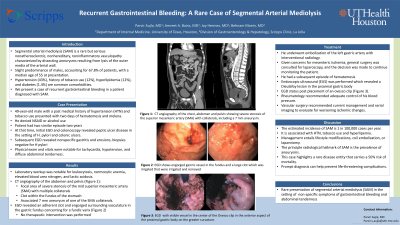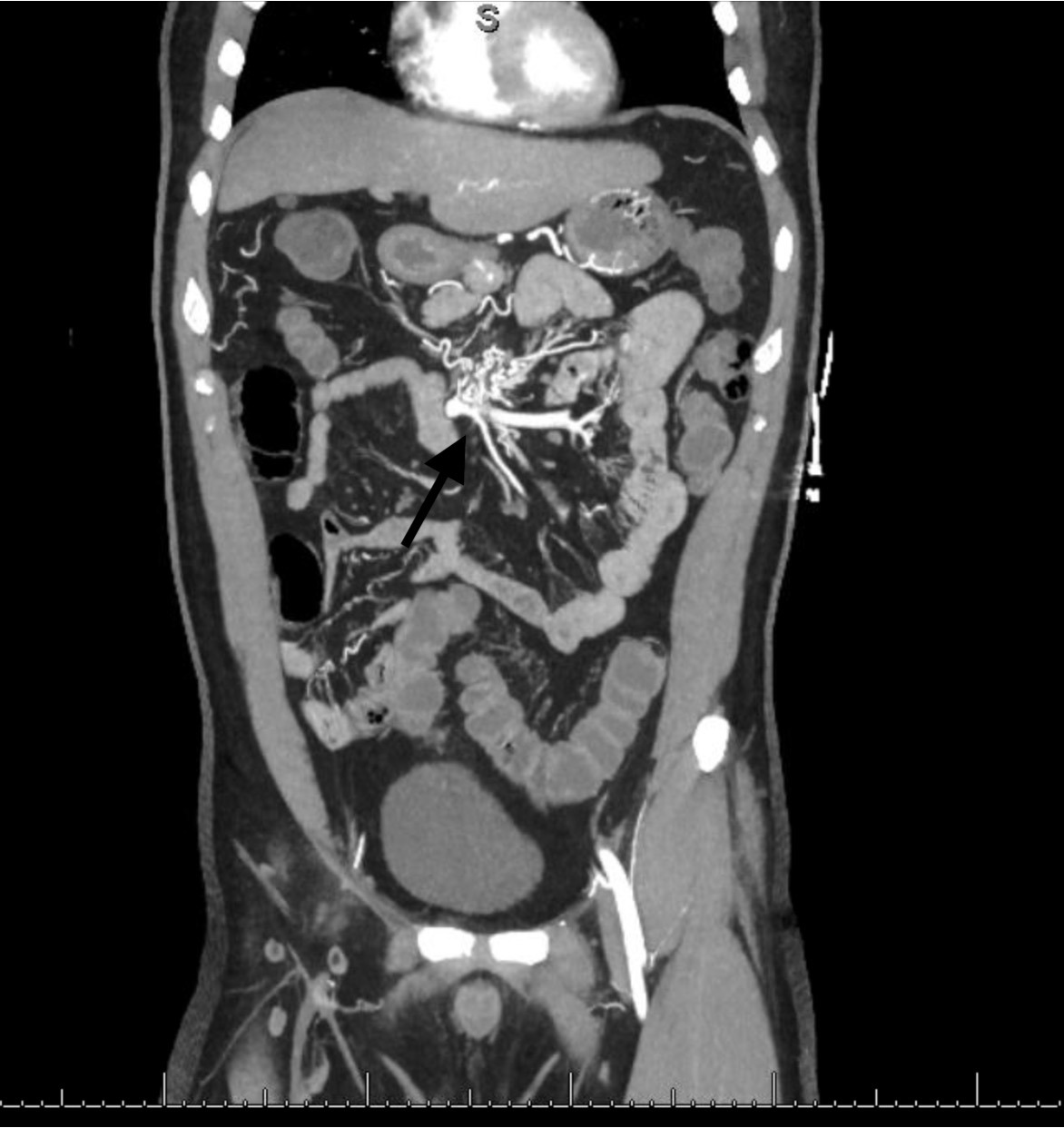Sunday Poster Session
Category: GI Bleeding
P0661 - Recurrent Gastrointestinal Bleeding: A Rare Case of Segmental Arterial Mediolysis
Sunday, October 22, 2023
3:30 PM - 7:00 PM PT
Location: Exhibit Hall

Has Audio

Parvir Aujla, MD
University of Texas Health Science Center
Houston, TX
Presenting Author(s)
Parvir Aujla, MD1, Amreet A. Bains, MD2, Joy Hermes, MD3, Behnam Moein, MD3
1University of Texas, Houston, TX; 2Scripps Green Hospital, Fresno, CA; 3Scripps Green Hospital, San Diego, CA
Introduction: Segmental arterial mediolysis (SAM) is a rare but serious non-atherosclerotic, non-inherited, non-inflammatory vasculopathy. It is characterized by dissecting aneurysms resulting from lysis of the outer media of the arterial wall. We present a case of recurrent gastrointestinal (GI) bleeding in a patient diagnosed with SAM.
Case Description/Methods: A 49-year-old male with a past medical history of hypertension (HTN) and tobacco use presented with two days of hematemesis and melena. He denied NSAID or alcohol use. Two years prior, the patient had two similar episodes at which time esophagogastroduodenoscopy (EGD) and colonoscopy revealed peptic ulcer disease in the setting of H. pylori and colonic ulcers. Subsequent EGD revealed nonspecific gastritis and erosions with biopsies negative for H. pylori. On admission, the patient was tachycardic and hypotensive. Laboratory workup was notable for leukocytosis, normocytic anemia, elevated blood urea nitrogen, and lactic acidosis. CT angiography abdomen and pelvis revealed a focal area of severe stenosis of the mid superior mesenteric artery (SMA) with multiple collaterals, a clot within the fundus of the stomach, and an associated 7 mm aneurysm of one of the SMA collaterals. The patient was adequately resuscitated and underwent an EGD which revealed an adherent clot and engorged surrounding vasculature in the gastric fundus concerning for a fundic varix. No therapeutic intervention was performed. He underwent embolization of the left gastric artery. Surgery was consulted for laparoscopy given concerns for mesenteric ischemia and a decision was made to monitor the patient. He had another episode of hematemesis and an endoscopic ultrasound was performed which revealed a Dieulafoy lesion in the proximal gastric body treated with the placement of an Ovesco clip. Multi-disciplinary care was provided with the assistance of Rheumatology and Vascular surgery who recommended blood pressure control and serial imaging to evaluate for progressive ischemic changes.
Discussion: The estimated incidence of SAM is 1 in 100,000 cases per year. It is associated with HTN, tobacco use, and hyperlipemia. The principle radiological hallmark of SAM is the prevalence of aneurysms. GI bleeding can be life-threatening with limited options for treatment. Management entails lifestyle modifications, coil embolization, or laparotomy. This case highlights a rare disease entity that carries a 50% risk of mortality. Prompt diagnosis can help prevent life-threatening complications.

Disclosures:
Parvir Aujla, MD1, Amreet A. Bains, MD2, Joy Hermes, MD3, Behnam Moein, MD3. P0661 - Recurrent Gastrointestinal Bleeding: A Rare Case of Segmental Arterial Mediolysis, ACG 2023 Annual Scientific Meeting Abstracts. Vancouver, BC, Canada: American College of Gastroenterology.
1University of Texas, Houston, TX; 2Scripps Green Hospital, Fresno, CA; 3Scripps Green Hospital, San Diego, CA
Introduction: Segmental arterial mediolysis (SAM) is a rare but serious non-atherosclerotic, non-inherited, non-inflammatory vasculopathy. It is characterized by dissecting aneurysms resulting from lysis of the outer media of the arterial wall. We present a case of recurrent gastrointestinal (GI) bleeding in a patient diagnosed with SAM.
Case Description/Methods: A 49-year-old male with a past medical history of hypertension (HTN) and tobacco use presented with two days of hematemesis and melena. He denied NSAID or alcohol use. Two years prior, the patient had two similar episodes at which time esophagogastroduodenoscopy (EGD) and colonoscopy revealed peptic ulcer disease in the setting of H. pylori and colonic ulcers. Subsequent EGD revealed nonspecific gastritis and erosions with biopsies negative for H. pylori. On admission, the patient was tachycardic and hypotensive. Laboratory workup was notable for leukocytosis, normocytic anemia, elevated blood urea nitrogen, and lactic acidosis. CT angiography abdomen and pelvis revealed a focal area of severe stenosis of the mid superior mesenteric artery (SMA) with multiple collaterals, a clot within the fundus of the stomach, and an associated 7 mm aneurysm of one of the SMA collaterals. The patient was adequately resuscitated and underwent an EGD which revealed an adherent clot and engorged surrounding vasculature in the gastric fundus concerning for a fundic varix. No therapeutic intervention was performed. He underwent embolization of the left gastric artery. Surgery was consulted for laparoscopy given concerns for mesenteric ischemia and a decision was made to monitor the patient. He had another episode of hematemesis and an endoscopic ultrasound was performed which revealed a Dieulafoy lesion in the proximal gastric body treated with the placement of an Ovesco clip. Multi-disciplinary care was provided with the assistance of Rheumatology and Vascular surgery who recommended blood pressure control and serial imaging to evaluate for progressive ischemic changes.
Discussion: The estimated incidence of SAM is 1 in 100,000 cases per year. It is associated with HTN, tobacco use, and hyperlipemia. The principle radiological hallmark of SAM is the prevalence of aneurysms. GI bleeding can be life-threatening with limited options for treatment. Management entails lifestyle modifications, coil embolization, or laparotomy. This case highlights a rare disease entity that carries a 50% risk of mortality. Prompt diagnosis can help prevent life-threatening complications.

Figure: Computed tomography angiography of the abdomen and pelvis: cross-sectional imaging revealing focal area of severe stenosis of the mid-superior mesenteric artery (SMA) with multiple collaterals and an associated 7 mm aneurysm of one of the SMA collaterals.
Disclosures:
Parvir Aujla indicated no relevant financial relationships.
Amreet Bains indicated no relevant financial relationships.
Joy Hermes indicated no relevant financial relationships.
Behnam Moein indicated no relevant financial relationships.
Parvir Aujla, MD1, Amreet A. Bains, MD2, Joy Hermes, MD3, Behnam Moein, MD3. P0661 - Recurrent Gastrointestinal Bleeding: A Rare Case of Segmental Arterial Mediolysis, ACG 2023 Annual Scientific Meeting Abstracts. Vancouver, BC, Canada: American College of Gastroenterology.
